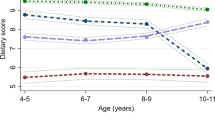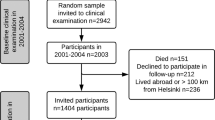Abstract
Objective: The initial stages of atherosclerosis have been shown to occur in children as young as 3. Elevated total and LDL cholesterol concentrations and low HDL concentrations are a well-established risk factor for atherosclerosis. The objective of this study was to investigate the dietary determinants of blood lipid concentrations at 31 months of age.
Subjects: A randomly selected group of children (214 boys, 175 girls) in south-west England forming part of the Avon Longitudinal Study of Pregnancy and Childhood (ALSPAC) cohort.
Design: Three-day dietary records were obtained at 18 months. At 31 months a non-fasting blood sample was taken and analysed for total and HDL cholesterol and triglyceride, and measures of height and weight were taken.
Results: Among boys, total cholesterol concentrations were positively associated with the intake of total fat (r=0.209, P=0.002) and saturated fatty acids (r=0.211, P=0.002). Among girls, HDLC was positively associated with energy intake (r=0.204, P=0.018), and negatively associated with intakes of polyunsaturated fat, saturated fat and sugar in multivariate analysis. There were no associations between the intakes of non-starch polysaccharides (fibre) or dietary cholesterol and total or HDL cholesterol concentrations in either sex. Among boys, higher intakes of breakfast cereals were associated with lower total cholesterol (r=−0.187, P=0.008). Among girls, higher intakes of biscuits and meat and meat products were associated with higher HDLC concentrations.
Conclusions: These data suggest that the dietary determinants of blood lipid concentrations differ between boys and girls. Reducing saturated fat intake in boys would be likely to lead to an improvement in blood lipid profiles. In this study there is no evidence to suggest that an increase in the intake of polyunsaturated fat by pre-school children would result in improved blood lipid profiles.
Sponsorship: Northern and Yorkshire Regional Health Authority NHS Research and Development Programme on Cardiovascular Disease and Stroke.
European Journal of Clinical Nutrition (2001) 55, 39–49
This is a preview of subscription content, access via your institution
Access options
Subscribe to this journal
Receive 12 print issues and online access
$259.00 per year
only $21.58 per issue
Buy this article
- Purchase on Springer Link
- Instant access to full article PDF
Prices may be subject to local taxes which are calculated during checkout
Similar content being viewed by others
Author information
Authors and Affiliations
Consortia
Contributions
Guarantors: I Cowin.
Contributors: PE designed the nutritional aspects of the CIF study, IC and PE collected the dietary data. Other data collection was performed by the ALSPAC study team. IC and PE conceived the project, and IC performed the statistical analyses and compiled the original report. All authors contributed to writing the paper.
Corresponding author
Rights and permissions
About this article
Cite this article
Cowin, I., Emmett, P. & the ALSPAC Study Team. Associations between dietary intakes and blood cholesterol concentrations at 31 months. Eur J Clin Nutr 55, 39–49 (2001). https://doi.org/10.1038/sj.ejcn.1601120
Received:
Revised:
Accepted:
Published:
Issue Date:
DOI: https://doi.org/10.1038/sj.ejcn.1601120
Keywords
This article is cited by
-
Validation of a Thai semiquantitative food frequency questionnaire (semi-FFQ) for people at risk of metabolic syndrome
Journal of Health, Population and Nutrition (2023)
-
Serum lipid and apolipoprotein levels in 4-year-old children are associated with parental levels and track over time
European Journal of Clinical Nutrition (2011)



